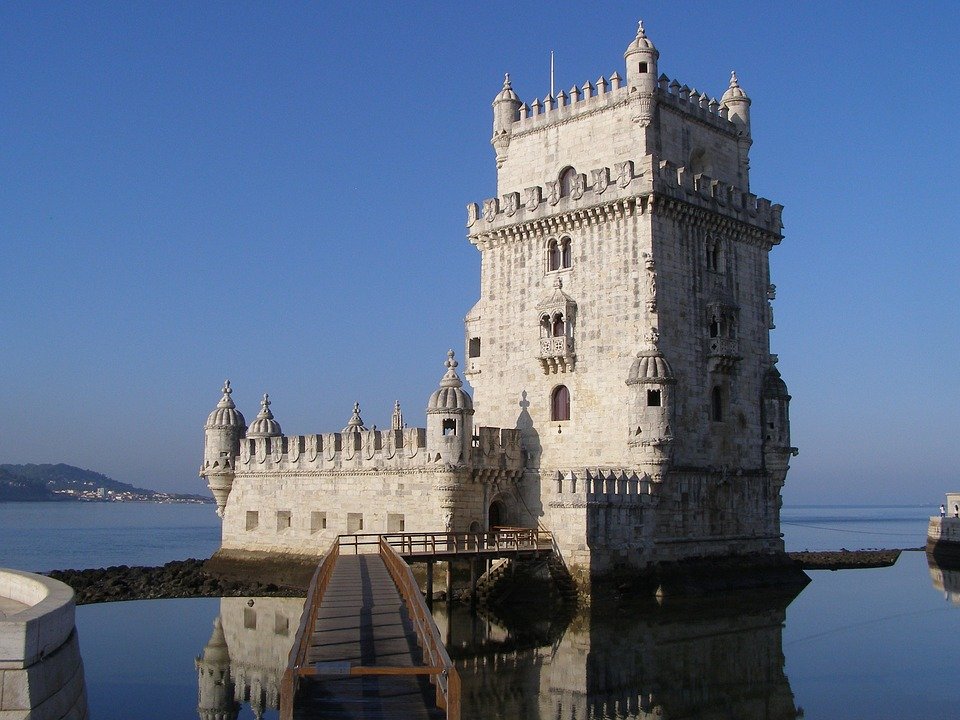Note: This article has been excerpted from a larger work in the public domain and shared here due to its historical value. It may contain outdated ideas and language that do not reflect TOTA’s opinions and beliefs.
“Torre de Belem.” from A Guide to Lisbon and its Environs, including Cintra and Mafra by Joaquim Antonio de Macedo, 1874.
Belem Tower is situated at the extreme W. of Lisbon, if we consider the suburb of Belem as forming part of the city. Its prominent position and picturesque appearance render it the first object that claims the visitor's attention on his entering the Tagus. Vessels entering the port stop in front of this tower to receive the customs and sanitary visits, and the passenger cannot fail to be struck with admiration by this graceful specimen of the military architecture prevailing at the end of the XV, century.
The original design was made by Garcia de Rasende, brother of the celebrated Andre de Rezende, in the reign of D. João II., and was intended to defend the port from the sudden attacks of pirates, at that time by no means uncommon. It was not, however, till 1495 in the reign of his successor D. Manuel surnamed the Great, that the project was put into execution, though doubtless with many modifications of the original design, as is abundantly obvious from the repeated introduction of the cross of the order of Christ and the armillary sphere, both emblems adopted by the latter monarch.
At the time of its erection it was completely surrounded by water, being built on a rock far removed from the shore, so that ships could sail between the tower and the land, and even down to the latter half of last century, small craft still made use of the northern channel. The tendency of the river to deposit sand on the N. bank; increased by the obstruction which the tower itself offered to the flowing waters, gradually caused an accumulation of sand which in the course of three centuries has united it with the land, forming a kind of promontory jutting into the river.
The building consists of two parts, the fortress and the tower. The former has a casemate with embrasures for 15 guns, now without artillery, and over it a platform with an embattled parapet, on which are seven cannon of ancient and elaborate workmanship. In a military point of view the fort is of little or no value, being armed with old fashioned guns, whose projectiles would make no impression whatever on the armor plated vessels of the present day, and whose walls, though ten feet thick, would be instantly shattered by modern artillery.
The tower is three stories high: on the first is the royal saloon called sala regia opening on to a balcony looking towards the river. This saloon possesses peculiar acoustic properties. Its roof is ellipsoidal and two persons placed at the foci at the opposite sides can converse with each other without their words being audible to those who may be in the middle of the room and consequently between the interlocutors. Above this are two other chambers and at the top a terrace from which a delightful prospect may be enjoyed.
The tower is often styled Torre de S. Vicente having been dedicated to St. Vincent in remembrance of the martyr's entry into the Tagus, when his remains were brought from the Promontorio Sacro to Lisbon in 1173. The tower is now used for firing salutes and as an occasional prison for military or political criminals. In an architectural point of view it is a most interesting exemplification of the Manueline style of Portuguese Gothic, as may be at once perceived on comparing it with its neighbor, the famous convent of St. Jerome, built also by king Emmanuel.
To the poet as well as to the archaeologist the tower of Belem is an object of enchantment and he must be indeed devoid of soul who can gaze unmoved on this venerable monument of by-gone glories, with its massive walls pitted by the finger of time, its crenellated terrace, the watch towers hanging in the air, and the flowered crosses of the order of Christ so delicately carved on the battlements; while he listens to the sound of the waves as they beat against its foundation, and to the whistling of the wind as it sweeps over its summit, reminding him that it was on this identical spot that the immortal Vasco da Gama set his foot, on returning from the discovery of a new empire.
Macedo, Joaquim Antonio de, A Guide to Lisbon and its Environs, including Cintra and Mafra, Simpkin, Marshall & Co., 1874.
About TOTA
TOTA.world provides cultural information and sharing across the world to help you explore your Family’s Cultural History and create deep connections with the lives and cultures of your ancestors.


